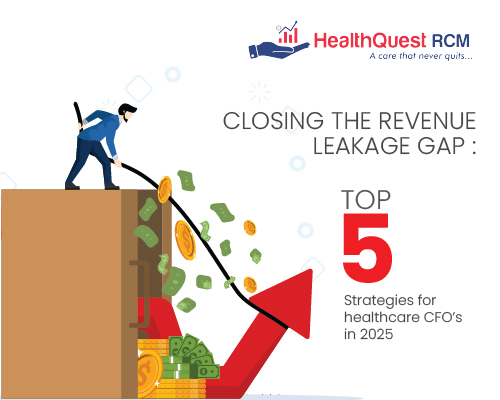Revenue leakage remains a critical challenge for healthcare CFOs, impacting financial sustainability and profitability. In 2025, strategic innovation is key to preventing revenue loss and improving financial efficiency. This blog explores five cutting-edge strategies healthcare CFOs can implement to close the revenue leakage gap.
Identifying Hidden Sources of Revenue Leakage
In complex healthcare organizations, revenue leakage often goes unnoticed. Common sources include:
- Coding Errors: Inaccurate medical coding leads to claim denials and revenue loss.
- Unbilled Services: Failure to capture all billable procedures results in lost income.
- Delayed Claims Processing: Inefficient workflows cause cash flow disruptions.
- Underpayments: Insurance companies may under-reimburse due to contract misalignment.
To combat these challenges, CFOs must conduct regular internal audits and invest in advanced revenue tracking systems that provide real-time insights into financial processes. Additionally, working closely with compliance teams ensures all claims meet regulatory standards, reducing denials and improving cash flow.
Strategic Integration of Technology Tools to Plug Revenue Gaps
The integration of technology in revenue cycle management (RCM) has transformed financial operations in healthcare. By leveraging cutting-edge tools, CFOs can optimize billing accuracy and improve revenue collection. Key solutions include:
- AI-Powered Revenue Cycle Management (RCM): Identifies discrepancies and optimizes claims processing by predicting potential errors before submission.
- Automated Billing Systems: Reduce manual errors, streamline patient invoicing, and accelerate payment cycles, leading to higher collections.
- Predictive Analytics: Uses historical data and trends to forecast potential financial risks, helping CFOs make informed decisions.
By adopting cloud-based financial solutions, healthcare organizations can gain real-time access to revenue cycle data, ensuring seamless monitoring and rapid response to emerging financial issues.
Creating a Culture of Revenue Integrity and Proactive Monitoring
A strong revenue integrity culture ensures that billing teams stay vigilant in preventing financial losses. Without consistent monitoring, even small inefficiencies can lead to substantial revenue loss over time. Strategies to enhance revenue integrity include:
- Regular Compliance Training: Conduct frequent workshops to educate teams on updated billing regulations, ensuring compliance with state and federal laws.
- Real-Time Audits: Implement automated audit systems that flag inconsistencies before they escalate into major financial setbacks.
- Performance-Based Incentives: Motivate employees by linking financial accuracy to reward programs, encouraging accountability and precision in financial reporting.
Encouraging cross-departmental collaboration between finance, IT, and administrative teams will further strengthen internal financial transparency and ensure all departments align with revenue optimization goals.
Leveraging Real-Time Revenue Dashboards to Pinpoint Issues
Revenue dashboards have become indispensable for healthcare CFOs, offering detailed insights into financial performance. These dashboards allow organizations to:
- Gain Instant Financial Oversight: Detect underpayments, claim denials, and outstanding balances in real-time.
- Customize Alerts: Set up automatic notifications for potential revenue risks, allowing quick corrective action.
- Utilize Data-Driven Decision-Making: Make informed financial adjustments based on historical data and predictive analytics.
By integrating AI-powered dashboards, CFOs can reduce financial bottlenecks and ensure proactive revenue cycle management, minimizing unexpected cash flow disruptions.
Benchmarking and Continuously Optimizing Performance Metrics
Ongoing benchmarking and performance optimization are crucial for sustained profitability. Healthcare CFOs should:
- Track Key Financial KPIs: Measure claim acceptance rates, revenue cycle efficiency, and payment timelines to gauge financial performance.
- Compare Against Industry Standards: Regularly evaluate revenue cycle performance against leading healthcare institutions to identify areas for improvement.
- Implement Continuous Improvement Strategies: Use data insights to refine workflows, adjust policies, and optimize overall financial operations.
Strategic benchmarking not only helps healthcare organizations maintain a competitive edge but also ensures they remain financially stable in the face of evolving industry regulations.
Conclusion
Revenue leakage prevention is a top priority for healthcare CFOs in 2025. By leveraging advanced analytics, automation, and strategic financial oversight, organizations can safeguard their revenue streams and enhance long-term profitability. Implementing these five innovative strategies will ensure healthcare CFOs stay ahead of financial risks while optimizing revenue performance.
Frequently Asked Questions
Revenue leakage refers to lost revenue due to inefficiencies such as billing errors, claim denials, and underpayments in the healthcare revenue cycle. It can also stem from lack of charge capture, inefficient payment follow-ups, and coding discrepancies.
Automation minimizes human errors, streamlines claims processing, and ensures accurate billing, significantly reducing financial losses. AI-driven claim scrubbing and automated denial management also contribute to better financial performance.
Predictive analytics use historical data to anticipate claim denials, forecast revenue trends, and identify areas of financial risk. This allows CFOs to proactively address revenue gaps before they escalate into major financial issues.
CFOs can maintain revenue integrity by implementing real-time audits, compliance training, and AI-driven financial monitoring tools. Additionally, fostering a culture of transparency and accountability among billing teams can further prevent financial losses.
Benchmarking helps CFOs compare their organization’s revenue cycle performance with industry standards, identify inefficiencies, and implement strategies for continuous revenue growth. Regular benchmarking ensures sustained financial health and regulatory compliance.

